Black and white are some of the easiest colors to match with.
Unlike other brighter colors, they blend with each other perfectly to create two different but balanced shades.
Even in our lives, we can see black and white colors being used to mark the street lines, signposts, and billboards.
This color combination also presents in the kingdom of animals that contribute to the richness of the fauna world.
Animals with bright colors do look appealing but black and white animals are certainly rare and unique in their own way.
That being said here are 23 beautiful black and white animals that exist in the vast array of other colorful animals in this world:
Table of Contents
1. Zebra
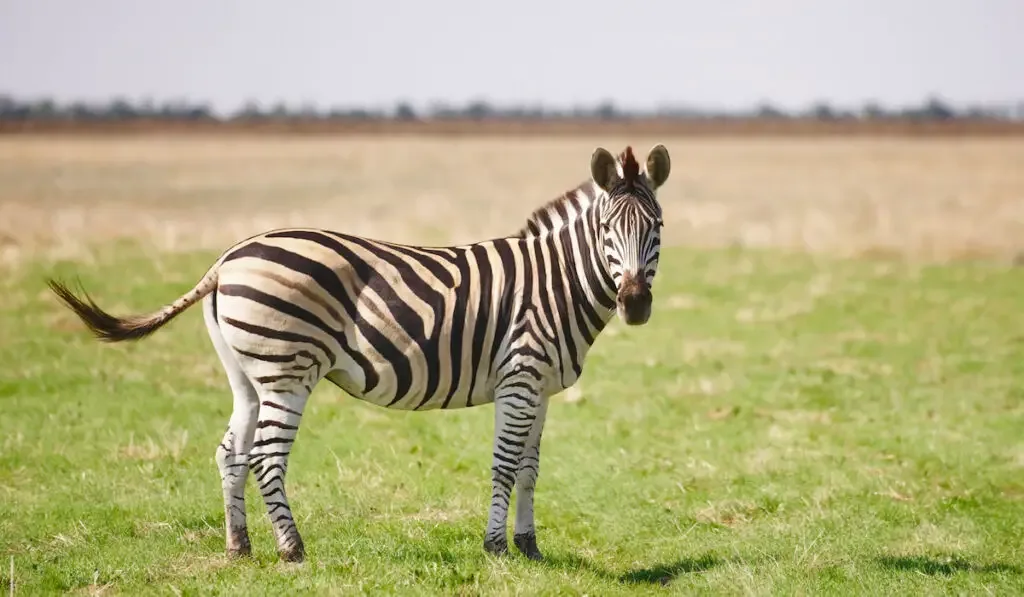
Zebras (Subgenus Hippotigris) are large species of equine that can be found in the plains of sub-Saharan Africa.
They generally stand between 4.2 and 5 feet and weigh around 550 to 990 pounds. Contrary to popular belief, Zebras don’t have white coats with black stripes.
In fact, what they have are black coats under white hair or stripes that serve as camouflage to protect them from predators.
These stripes are also unique to each zebra. There is no zebra with the same stripe pattern.
Zebras are social animals and tend to stay in a group when moving or looking for food and water.
There are three different species of zebras: The plain zebras, the mountain zebras, and the Grevy’s zebras.
2. Malayan Tapir
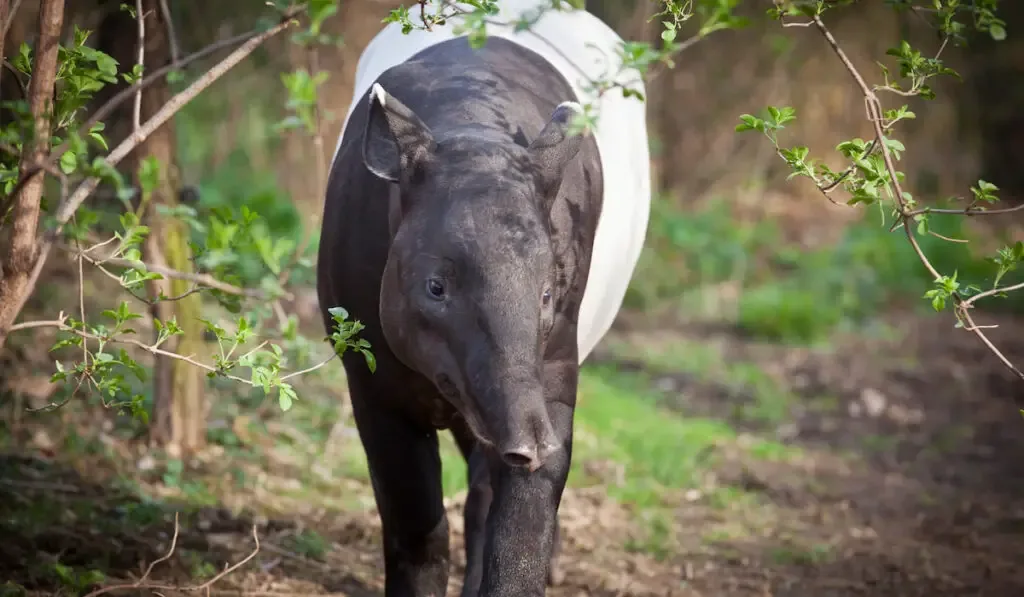
The Malayan Tapirs (Tapirus Indicus) are forest dwellers that are now considered an endangered species.
Considered the world’s biggest tapir, they can only be found in the Malayan Peninsula, the island of Sumatra, Vietnam, and Thailand.
Malayan Tapirs grow up to 8.2 feet in length, 3.6 feet in height, and weigh around 551 to 1190 pounds.
They have large, sturdy, black and white bodies with prehensile proboscis. Four toes are found on their forefeet while their hind feet are equipped with three toes.
Female tapirs are much larger than males. Malayan Tapirs are considered as folivores, frugivores, and lignivores.
They usually eat green leaves, twigs, growing bark, and herbs, as well as tubers and aquatic plants.
3. Giant Panda
Giants pandas (Ailuropoda melanoleuca) are native to central China and can also be found in the dense, misty bamboo forests in the mountains of Southern China.
They are widely known for their cute, huggable appearance and their distinctive black and white coat.
They have been included in the logo of the World Wildlife Federation since 1961.
Giant pandas stand between 4 and 5 feet tall and weigh around 300 pounds. They have a long lifespan of around 20 years.
Being omnivores, their diet consists of green leaves, bamboo shoots, and occasionally fish or small animals.
Their thick, wooly coats insulate them from the cold and rainy weather in their habitats.
Although they are mostly solitary, giant pandas will occasionally communicate with other pandas through scent marks, calls, and physical encounters.
4. Giant Leopard Moth
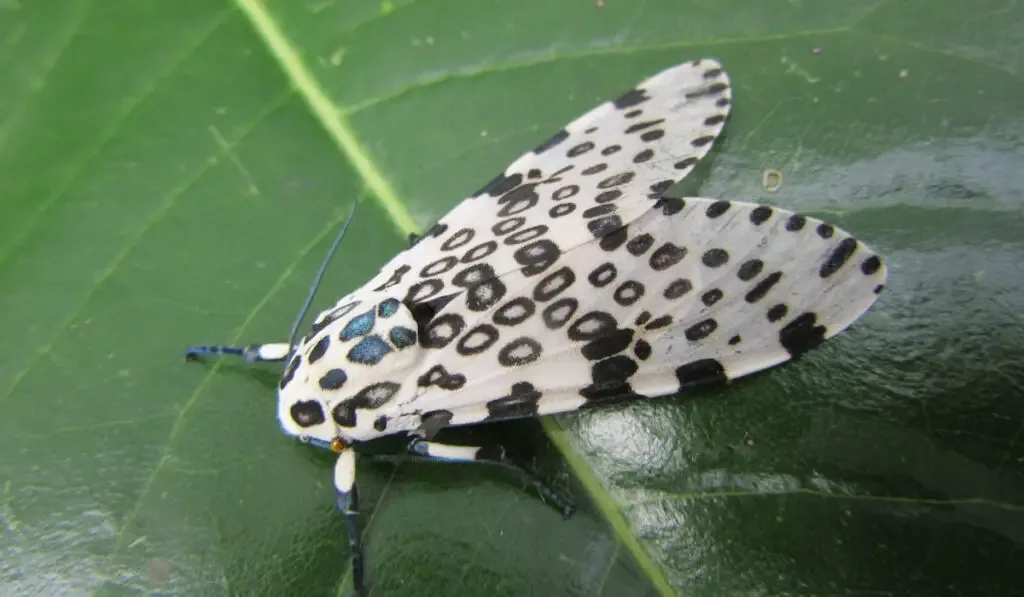
Also known as Hypercompe Scribonia and Eastern Tiger Moths, these moths can be found in Massachusetts, from southern Ontario to Florida, west to Michigan, Texas, and Missouri.
They can be easily recognized by their bright white wings with solid or hollow black spots scattered all over them. Some black and white bands could also be found on their legs.
Giant leopard moths generally have a wingspan of 2.24 to 3.6 inches.
They generally grow from medium-sized, red-striped, wooly-bear caterpillars that feed on different kinds of plants like dandelions, lettuce, basil, sunflowers, and leaves from some larger trees like cherries, willows, mulberries, and maples.
They are mostly active at night and attracted to any source of light.
5. Clark’s Nutcracker
Clark’s Nutcrackers (Nucifraga columbiana) can be commonly found in high mountains of the West, coniferous forests of high elevations, and pine forests.
They inhabit places that are remote from human contact and feed on pine seeds, berries, and nuts, as well as flying insects, snails, and suet.
One of the distinctive traits that separate these birds from other birds is the pouch under their tongue that they use to carry seeds. They will store those seeds and feed them to their nestlings.
Female Clark’s Nutcrackers will lay between 4 to 6 pale green eggs at a time. These eggs will be incubated between 16 to 18 days before they finally hatch.
They build their nests up high in coniferous trees, around 8 to 40 feet above the ground.
6. Siberian Husky
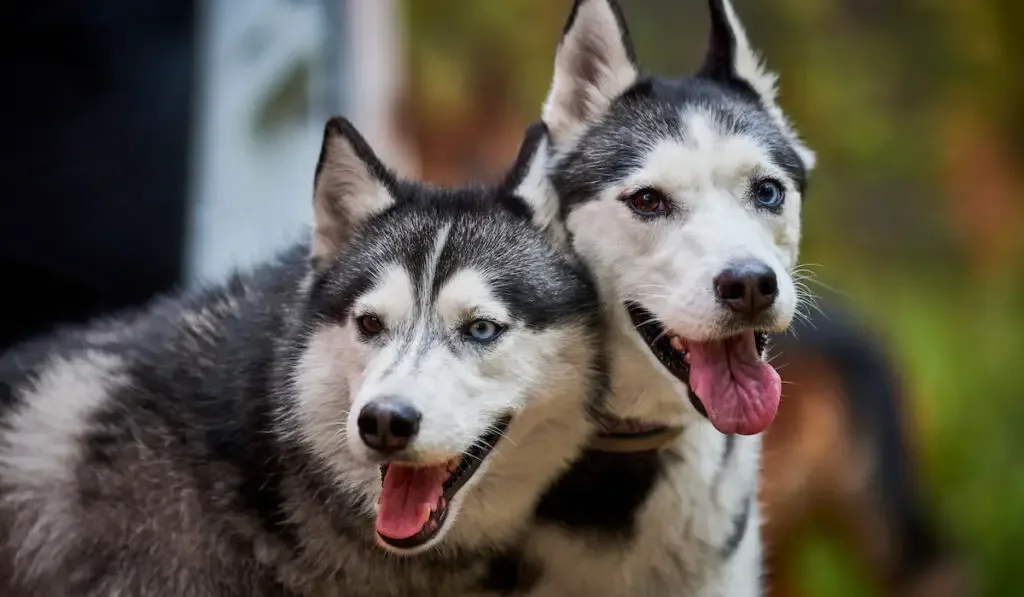
These medium-sized dogs are one of the fluffiest and most beautiful dogs that attract everyone’s attention.
Siberian Huskies are well-known for their dense double coat that comes in different colors like black, gray, tan, and white.
They stand between 20 to 23.5 inches at the shoulder and weigh around 35 to 60 pounds
Many owners of these Huskies love their athletic, intelligent, and warm personalities.
Siberian Huskies are considered a natural breed and they will always do self-cleaning without many baths needed. But to keep their coats healthy, regular grooming is required, at least once a week.
7. Holstein Cow

Holstein cows originated in Europe around 2,000 years ago. They were bred by crossing two different cattle breeds; the black Batavians and the white Friesians. As a result, Holstein cows were developed where they could produce a high amount of milk.
The Holsteins are easily recognized by their white color and distinctive irregular-shaped spots scattered all over their bodies.
Considered as the most excellent milk producer, these dairy cows can produce up to 67, 914 pounds of milk per year. Nowadays, Holstein are found all over the world.
Their average lifespan is around six years but the healthiest ones can also live longer and produce more milk.
8. Striped Skunk
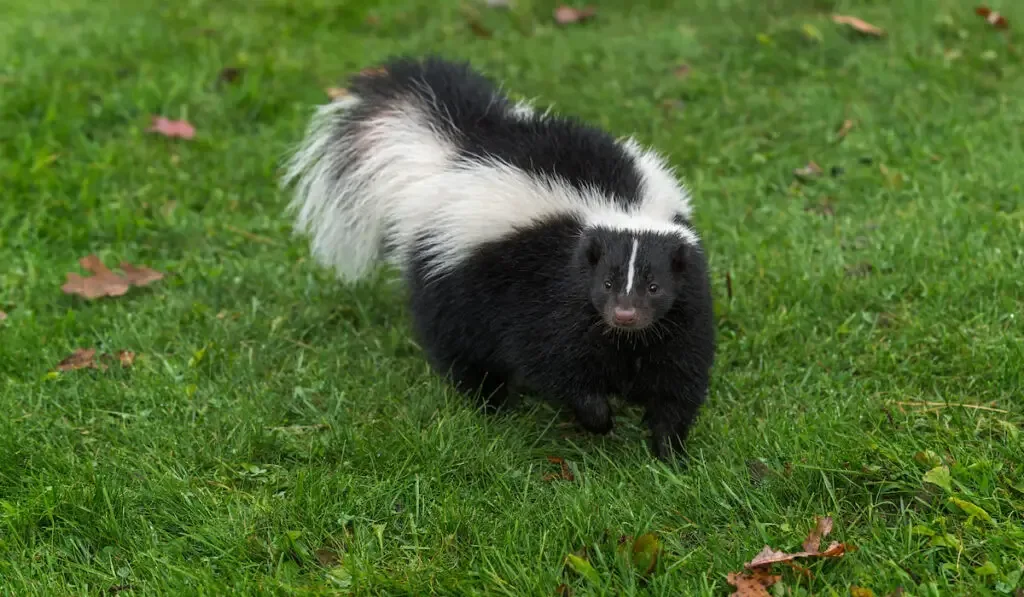
Striped skunks (Mephitis mephitis) are abundantly found in North and South America, as well as from the southern part of Canada to the northern part of Mexico.
Their average size is between 20 to 30 inches including the tail and weighs around 6 to 10 pounds.
They have black and white fur, with strong forefeet and long claws that are useful for digging.
One of the most distinctive physical traits of striped skunks is the glands under their bushy long tail. These glands contain oily liquid that serves to protect them from predators.
They will spray a foul mist that can linger for many days on any animals that are capable of harming them.
Being nocturnal, they will search for different kinds of food at night including fruits, plants, rodents, small insects, and birds.
9. White Tiger
These majestic-looking tigers are native to Asia and Eurasia and are considered an endangered species.
Also known as the White Bengal tigers (Panthera tigris tigris), their body length can reach up to 11 feet and weigh around 309 to 660 pounds.
The white tigers are definitely unique due to their blue eyes, white fur, and beautiful black stripes. This is also due to the lack of pigment called pheomelanin that contributes to the color of their fur.
Considered agile and prolific hunters, they can run up 60 miles per hour.
Unlike normal orange tigers, white tigers generally grow faster and are fully grown after 2 to 3 years.
10. California Kingsnake
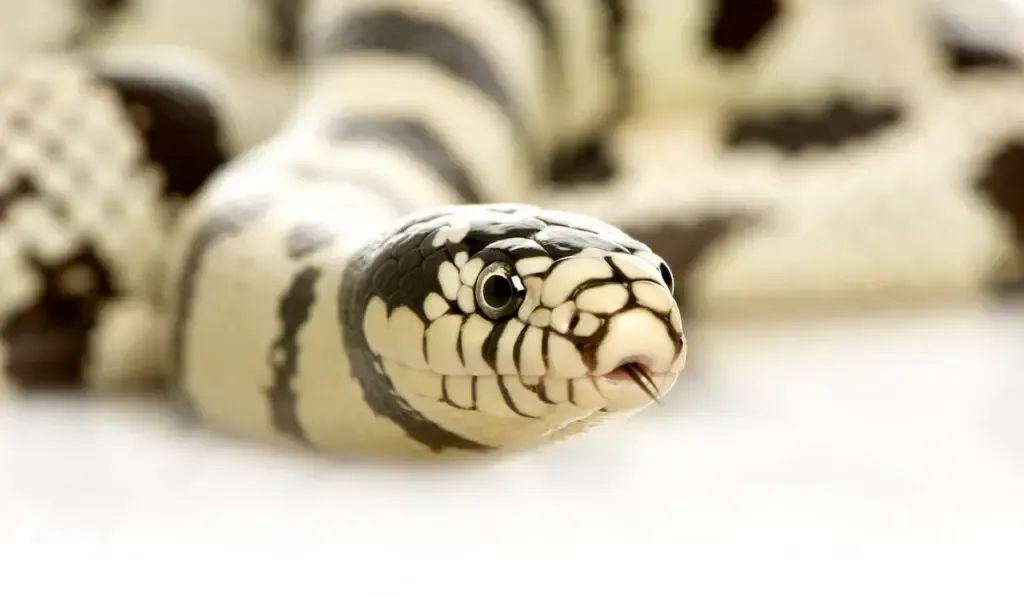
California kingsnakes (Lampropeltis getula californiae) originated in California and are widely distributed throughout the state of Oregon, Nevada, Arizona, and Baja California.
Adult kingsnakes reach up to 6 feet in length and weigh around 1.3 to 1.8 pounds.
They usually come in a combination of white, black, and brown color. They also have two different patterns; the ringed pattern and the striped pattern.
These snakes are carnivores and feed on other animals like rats, frogs, birds, and other smaller snakes.
They are considered constrictor snakes because they constrict their prey to death before eating them.
Many exotic animal lovers adopt California kingsnakes as pets due to their long lifespan of around 20 to 30 years.
11. Osprey Bird
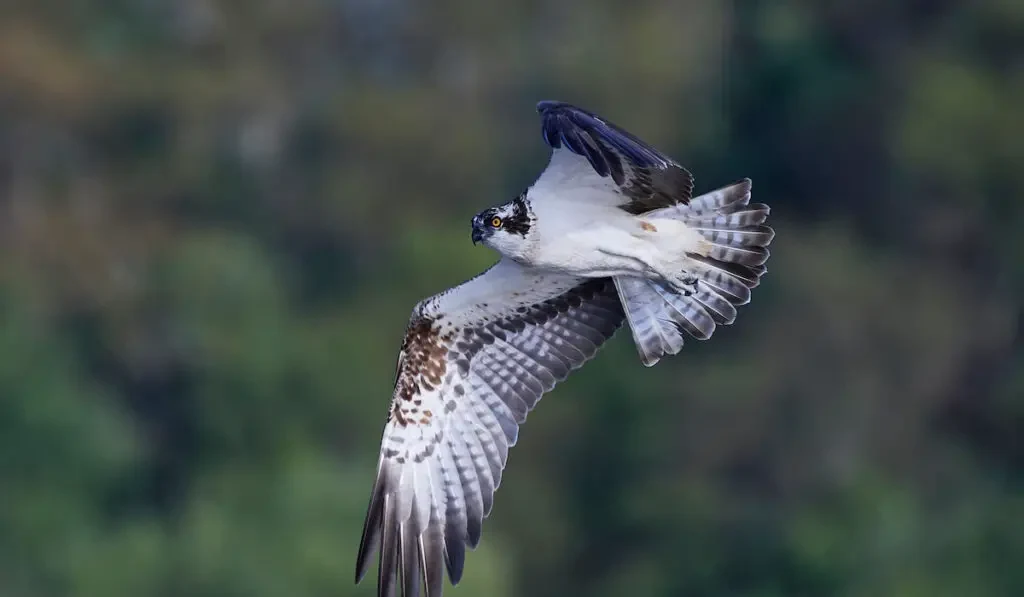
These hawk-like large birds are carnivorous birds with dark brown backs, white heads, wings, and underparts.
Ospreys measure between 21 to 23 inches in length and weigh around 3.1 to 4.4 pounds.
They have a wingspan of 5 to 6 feet. These birds can be found in every continent, except Antarctica.
Ospreys inhabit rivers, ponds, reservoirs, or any body of water and build their stick nests on the poles and dead trees as well as channel markers.
They hunt fish by diving to the surface of the water from 30 to 100 feet up. Their curved claws help in grabbing fish before carrying them to their nest.
12. Dall’s Porpoise
Considered as the biggest of all porpoises, Dall’s porpoise (Phocoenoides dalli) can be easily recognized by black bodies and bright white patches found on their belly and flanks.
They can be found in the North Pacific Ocean and along the West Coast of North America as far south as Southern California.
They are named after W.H. Dall, an American naturalist who collected the very first specimen of this species.
These porpoises possess a small head, small flippers, and a robust tailstock. They generally measure between 7 and 8 feet in length and weigh around 440 pounds.
Dall’s porpoises generally live between 8 to 20 years and feed mostly on different kinds of fish and cephalopods.
In some cases, they are preyed upon by Bigg’s killer whales. They move in groups of 2 to 12 and swim swiftly across the sea.
13. Black-And-White Ruffed Lemur
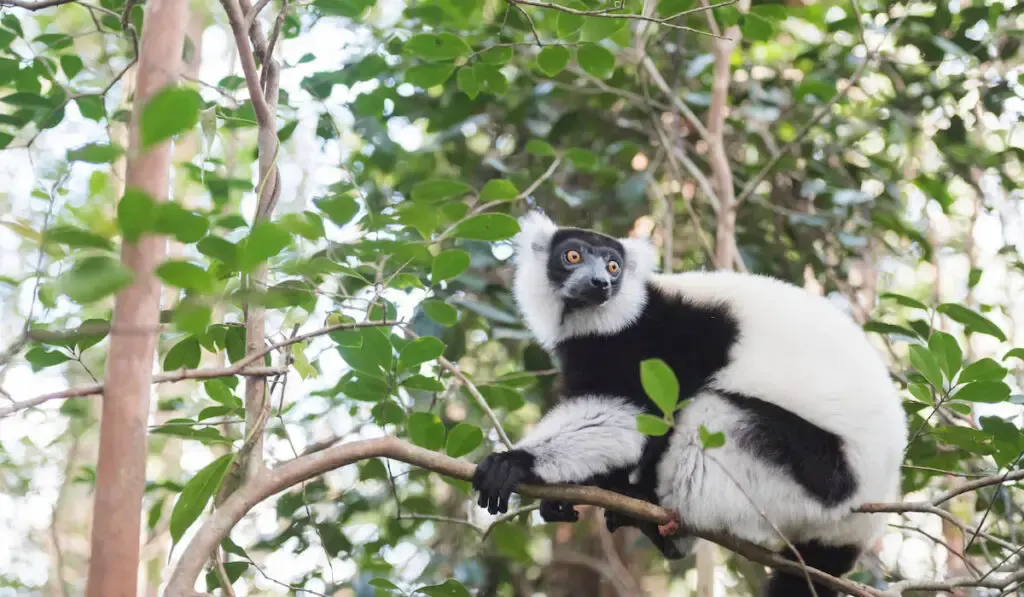
These cute and adorable lemurs originated from the tropical forests of eastern Madagascar.
Black-and-white ruffed lemurs (Varecia variegata) possess a black and white coat, bright yellow eyes, long tails, and white tufted ears. Their thick coat protects them from wet and cold rainforest environments.
They generally measure around 20 inches in length and weigh around 7.7 to 10 pounds. These lemurs mostly feed on fruits, seeds, leaves, nectars, as well as pollen.
In the tropical forest of Madagascar, they act as excellent pollinators of plants.
Black-and-white ruffed lemurs move and live in a group of 2 to 5. But in some cases, they live in a very large group of 30 individuals.
14. Dalmatian Dog
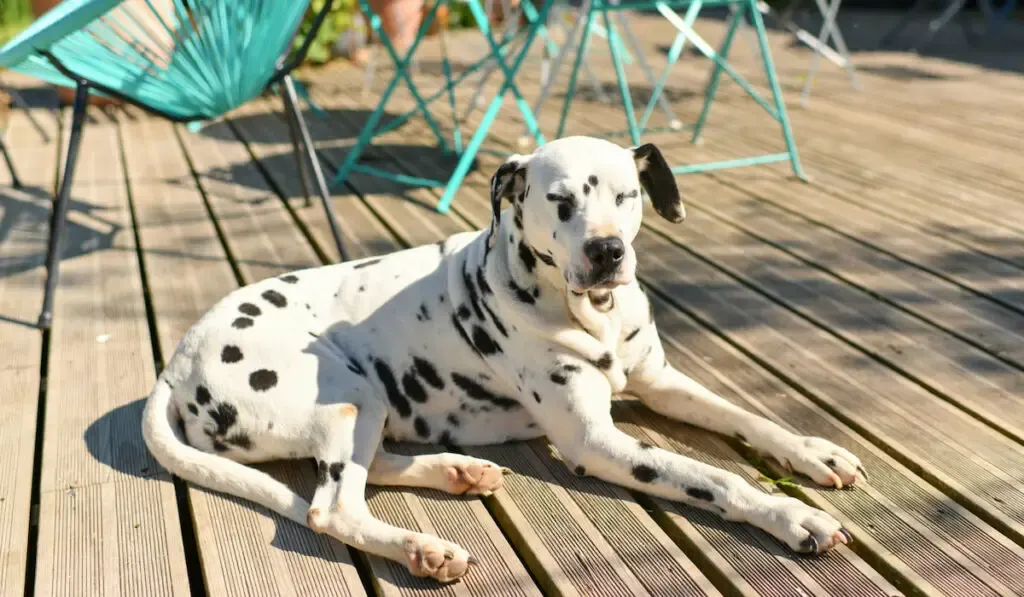
Dalmatian dogs were originally bred for carriages purposes and providing aesthetic values to aristocrats in the Old World.
But today, these unique dogs are adopted by many dog lovers as family dogs and companions. The Dalmatians are characterized by their white body with random black spots.
They stand tall between 19 to 23 inches and weigh around 45 to 60 pounds. With their short and dense coat, they don’t require much grooming.
The Dalmatians are highly energetic, playful, and athletic dogs.
They love human companions and are loyal to their owners. Adopting these dogs as companions is certainly be a great choice due to their long lifespan or around 10 to 12 years.
15. Adelie Penguin
Like most penguins, The Adelies (Pygoscelis Adeliae) is only found in the Antarctic continent.
They measure around 27.5 inches in length and weigh around 8 to 11 pounds. These penguins also possess a black face, head, tail, and a white belly with white rings around their brown eyes.
Adelies mostly inhabit and nest on the rocky shores of the Antarctic. They feed on smaller aquatic creatures like krill, fish, and squids.
The male and female Adelies are good parents and each parent takes turns in caring for and incubating their eggs until they hatch.
Adelies have a longer lifespan of around 11 to 20 years. They live in a large community and move around in a big group.
16. Zebra Swallowtail Butterfly
Zebra swallowtails (Protographium Marcellus) are one of the exotic butterflies species that are abundantly distributed from southern New England west to eastern Kansas and south to Florida and Texas.
They are also called the pawpaw butterflies, kite swallowtails, and ajax.
They are easily recognized by their black and white stripes and long hind wing tails.
Adults swallowtails generally have a wingspan of around 2 to 4.5 inches. Meanwhile, the caterpillars are hairless, bluish-green, with distinctive yellow and white bands.
These butterflies inhabit moist, forested areas and feed on nectars from flowers like milkweed, redbud, and verbena. Occasionally, they also gather in creek beds and at mud puddles.
17. Common Eider

These beautiful black and white sea ducks are the largest ducks that can be found in the northern hemisphere.
They measure between 20 to 28 inches in length and weigh around 4 to 9 pounds.
Common eiders (Somateria mollissima) are also known by their other names like the Cuddy’s duck or the St. Cuthbert’s duck.
Males eiders can be differentiated from females by their black V-shape on their chin and a bright yellow bill.
Females differ in colors from the males; they have brown to dull grayish plumage.
Common eiders mainly feed on mollusks and crustaceans including mussels, crabs, clams, sea urchins, scallops, and starfish.
18. Black-and-White Warbler
Black-and-white warblers (Mniotilta varia) are medium-sized warblers that can be found in many regions including northern and eastern America, Central America, Florida, and the West Indies down to Peru.
They measure between 4.3 to 5.1 inches in length and weigh around 2 to 3 ounces. They have a wingspan of 7.1 to 8.7 inches.
These warblers possess a black and white-striped plumage and black feet. During summer, they inhabit deciduous and mixed forests before migrating to forests in Florida and Colombia in the winter.
Black-and-white warblers feed on insects on tree trunks and branches. They also prey on flying insects like flies, beetles, leafhoppers, as well as arachnids like non-venomous spiders.
19. Black-billed Magpie

Black-billed magpies (Pica Hudsonia) can be found in western North America and commonly inhabit grasslands, meadows, forest edges, as well as other semi-open regions in the West.
These medium-sized birds possess a black head, chest, back, and long tail with large patches of white on their wings.
They measure between 18 to 24 inches and weigh around 0.2 to 0.4 pounds. They have a wingspan of 22 to 24 inches.
Black-billed magpies feed on many things including fruits, seeds, grasshoppers, beetles, as well as other smaller animals like voles and squirrels.
They generally live up to 15 years. In the early 20th century, many of them were killed and poisoned due to being viewed as pests but their population still remains large today.
20. African-striped Weasel
Although they look like skunks, African-striped weasels (Poecilogale albinucha) are totally different animals that can be found throughout sub-Saharan Africa.
They inhabit many regions but mostly settle in grasslands, forest edges, and marsh regions.
The African-striped weasels measure around 10 to 14 inches and weigh around 8 to 13 ounces. They have black fur with white patches on top of their head and parallel white stripes that run down their back.
Being carnivores, they feed on small mammals, snakes, birds, insects, and eggs. They usually will hunt their prey at night.
They move silently on the ground and stay as far as possible from any trees to avoid being detected by predators like owls.
21. Angolan Colobus Monkey
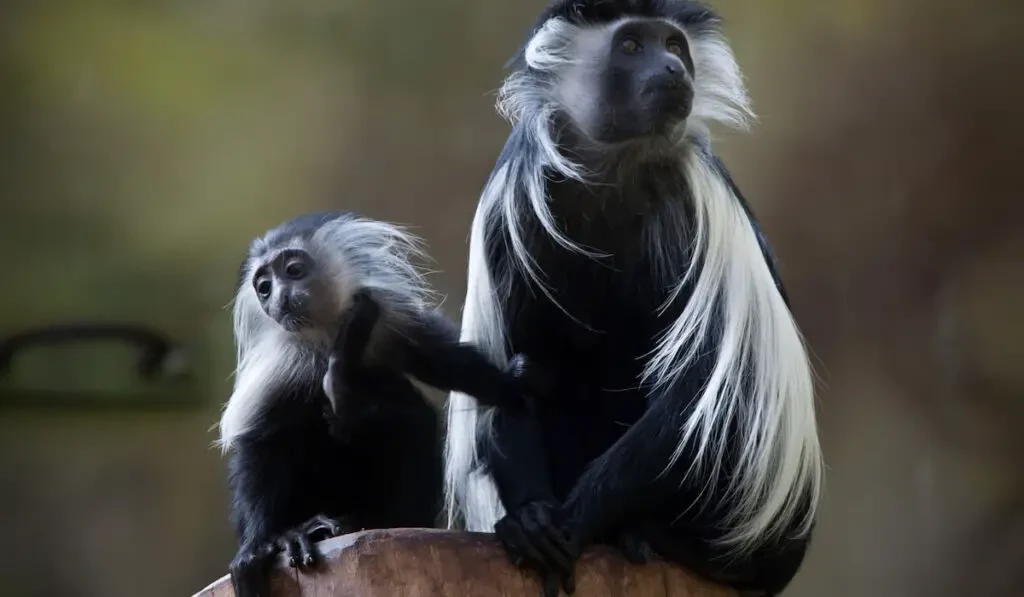
Angolan Colobus (Colobus Angolensis) monkeys can mostly be found in tropical forests of Africa but they also are distributed in other regions like northern Congo, from eastern Nigeria through Cameroon, Uganda, Ethiopia, as well as Kenya.
These medium-sized, arboreal monkeys possess long, glossy black coats with white mantle fur and whiskers, and a white beard.
They have long and bushy white tails. Angolan monkeys measure around 35 inches long and weigh between 15 and 30 pounds.
They mostly feed on fruits, green leaves, and edible plants. Most of the time, they move and settle in a very large group, which can reach up to 450.
22. Killer Whale
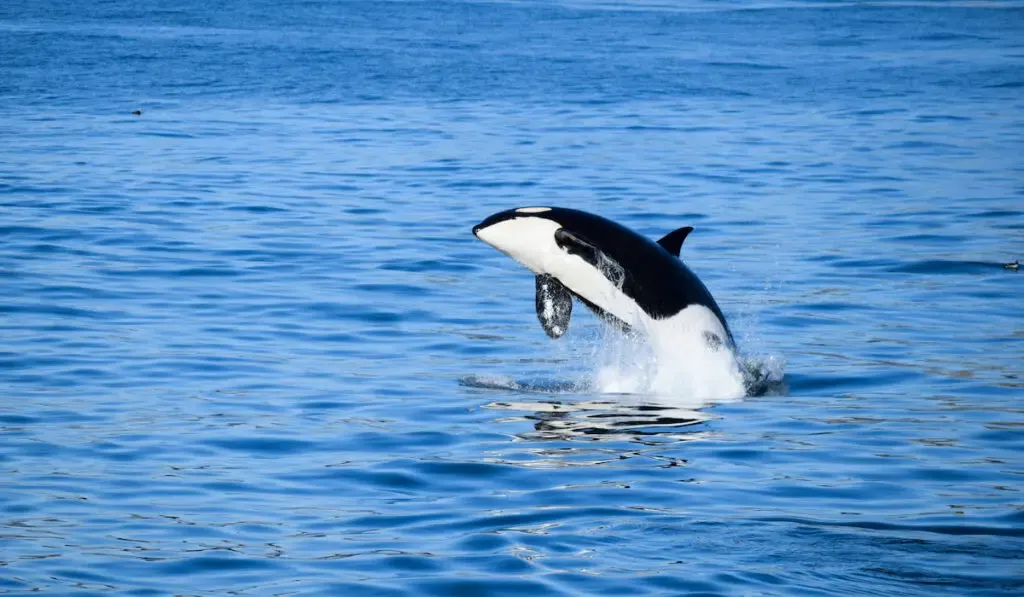
Killer whales (Orcinus Orca), also known as Orcas, are the largest member of the dolphin family.
They are well-known for their striking black and white body. They also have a black dorsal surface and pectoral flippers and white patches located just behind their eyes.
Orcas generally measure between 16 to 22 feet and weigh around 3 to 4 ton. They can be found swimming in the coastal and offshore waters, as well as localized waterways and oceans worldwide.
Being apex predators, they mainly feed on fish, seals, squids, sea birds, and great white sharks. They can live up to 100 years, which is quite a long lifespan for any mammal.
23. Royal Palm Turkey
Royal Palm Turkeys are domesticated turkeys that originated from United Kingdom. They have been in Florida since the 1920s.
These turkeys possess a white body plumage with metallic black edging on their feathers.
They have red heads, throats, wattles, and black beard. Royal Palm toms generally weigh 16 to 22 pounds while the hens weigh around 10 to 12 pounds.
The toms are less aggressive compared to hens who tend to become protective of their chicks.
The hens lay pale cream to brown eggs with spots. Royal Palm turkeys are mainly raised for exhibition purposes and kept at farms, not for their meat like other turkeys.
Aside from being good flyers, they are also active, thrifty, and excellent foragers.
Final Thoughts
The black and white color combination causes all of these animals to stand out in a crowd of color.
But putting aesthetic value aside, this distinctive physical trait also helps them to survive in the wild and keeps predators away.
As humans, the best thing we can do is protect and conserve these precious animals so that they may live longer.
The future generation will be thankful when they get to witness and still cherish the beauty of all these animals.
Resources
Zebra
- https://kids.nationalgeographic.com/animals/mammals/facts/zebra
- https://animals.sandiegozoo.org/animals/zebra
- https://www.nationalgeographic.com/animals/mammals/facts/plains-zebra
Malayan Tapir
- https://www.tapirday.org/malayan-tapir.html
- https://news.mongabay.com/2016/09/black-white-and-unique-the-malayan-tapir-struggles-for-recognition/
- https://animaldiversity.org/accounts/Tapirus_indicus/
Giant Panda
- https://kids.nationalgeographic.com/animals/mammals/facts/giant-panda
- https://nationalzoo.si.edu/animals/giant-panda
- https://www.worldwildlife.org/species/giant-panda
Giant Leopard Moth
- https://www.aaas.org/news/weird-wonderful-creatures-giant-leopard-moth
- https://georgiawildlife.com/out-my-backdoor-meet-giant-leopard-moth
- http://entnemdept.ufl.edu/creatures/MISC/MOTHS/Hypercompe_scribonia.htm
Clark’s Nutcracker
- https://www.allaboutbirds.org/guide/Clarks_Nutcracker/overview
- https://ebird.org/species/clanut
- https://www.audubon.org/field-guide/bird/clarks-nutcracker
Siberian Husky
- https://dogtime.com/dog-breeds/siberian-husky#/slide/1
- https://www.akc.org/dog-breeds/siberian-husky/
- https://www.thesprucepets.com/siberian-husky-dog-breed-profile-1118000
Holstein Cow
- http://afs.okstate.edu/breeds/cattle/holstein/
- https://www.thecattlesite.com/breeds/dairy/22/holstein/
- https://www.canr.msu.edu/news/history_of_dairy_cow_breeds_holstein
Striped Skunk
- https://www.nationalgeographic.com/animals/mammals/facts/striped-skunk
- https://kids.nationalgeographic.com/animals/mammals/facts/skunk
- https://www.havahart.com/skunk-facts
White Tiger
- https://www.balisafarimarinepark.com/white-tiger-facts/
- https://wildwelfare.org/white-tigers/
- https://a-z-animals.com/animals/white-tiger/
California King Snake
- https://www.everythingreptiles.com/california-kingsnake/
- https://www.reptilesmagazine.com/california-kingsnake-care-sheet/
- https://www.britannica.com/animal/colubrid
Osprey Bird
- https://www.allaboutbirds.org/guide/Osprey/id
- https://ebird.org/species/osprey
- https://www.nationalgeographic.com/animals/birds/facts/osprey
Dall’s Porpoise
- https://porpoise.org/about-porpoises/dalls-porpoise/
- https://www.fisheries.noaa.gov/species/dalls-porpoise
- https://uk.whales.org/whales-dolphins/species-guide/dalls-porpoise/
Black-And-White Ruffed Lemur
- https://lemur.duke.edu/discover/meet-the-lemurs/black-white-ruffed-lemur/
- https://perthzoo.wa.gov.au/animal/black-and-white-ruffed-lemur
- https://www.folly-farm.co.uk/zoo/meet-the-zoo-animals/black-and-white-ruffed-lemur/
Dalmatian Dog
- https://dogtime.com/dog-breeds/dalmatian#/slide/1
- https://www.hillspet.com/dog-care/dog-breeds/dalmatian
- https://www.akc.org/dog-breeds/dalmatian/
Adelie Penguin
- https://oceana.org/marine-life/seabirds/adelie-penguin
- https://www.nationalgeographic.com/animals/birds/facts/adelie-penguin
- https://animaldiversity.org/accounts/Pygoscelis_adeliae/
Zebra Swallowtail Butterfly
- https://mdc.mo.gov/discover-nature/field-guide/zebra-swallowtail
- http://entnemdept.ufl.edu/creatures/bfly/zebra_swallowtail.htm
- https://www.chesapeakebay.net/S=0/fieldguide/critter/zebra_swallowtail
Common Eider
- https://www.hww.ca/en/wildlife/birds/common-eider.html
- https://www.allaboutbirds.org/guide/Common_Eider/overview
- https://ebird.org/species/comeid
Black And White Warbler
- https://www.audubon.org/field-guide/bird/black-and-white-warbler
- https://ebird.org/species/bawwar
- https://www.allaboutbirds.org/guide/Black-and-white_Warbler/id
Black-billed Magpie
- https://celebrateurbanbirds.org/learn/birds/focal-species/black-billed-magpie/
- https://www.audubon.org/field-guide/bird/black-billed-magpie
- https://animaldiversity.org/accounts/Pica_hudsonia/
African-striped weasel
- https://thewebsiteofeverything.com/animals/mammals/Carnivora/Mustelidae/Poecilogale/Poecilogale-albinucha.html
- https://animaldiversity.org/accounts/Poecilogale_albinucha/
- https://www.krugerpark.co.za/africa_african_weasel.html
Angolan Colobus
- https://animaldiversity.org/accounts/Colobus_angolensis/
- https://rwanda.wcs.org/Wildlife/Angolan-B-W-Colobus.aspx
- https://zooatlanta.org/animal/angolan-colobus-monkey/
Killer Whale (Orca)
- https://www.livescience.com/27431-orcas-killer-whales.html
- https://oceana.org/marine-life/marine-mammals/orca
- https://seaworld.org/animals/facts/mammals/killer-whale/
Royal Palm Turkey

